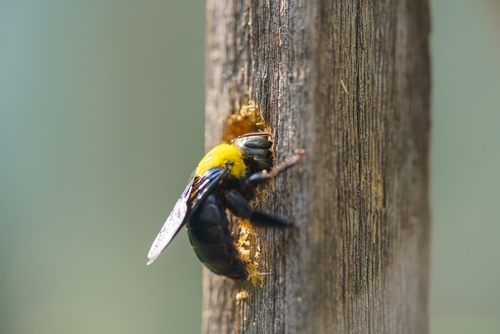
Buzzing Trouble: Understanding Carpenter Bees in New Jersey
As spring arrives in New Jersey, so do the buzzing sounds of carpenter bees. While these bees may seem harmless, they can cause significant damage to wooden structures around homes and properties. In this blog post, we’ll explore what carpenter bees are, how to identify them, the damage they create, and effective measures to address and prevent infestations.
What are Carpenter Bees?
Carpenter bees, scientifically known as Xylocopa species, are large, solitary bees commonly found in New Jersey and other regions of the United States. These bees are often mistaken for bumblebees due to their similar appearance, but they differ in behavior and nesting habits.
How to Identify Carpenter Bees
Identifying carpenter bees is relatively straightforward. They are large bees with shiny, black abdomens and a noticeable lack of yellow markings. Additionally, male carpenter bees may exhibit aggressive behavior, hovering near potential nesting sites to protect their territory.
Do Carpenter Bees Cause Damage?
The short answer is, ABSOLUTELY! While carpenter bees do not consume wood for nutrition like termites, they create tunnels and galleries within wooden structures for nesting purposes. Over time, these tunnels can weaken the integrity of wooden beams, decks, fences, and other structures, potentially leading to structural damage and safety hazards.
According to the Rutgers New Jersey Agricultural Experiment Station (NJAES), carpenter bees prefer untreated and unpainted wood, particularly cedar, redwood, and cypress [1]. They tend to target softwoods, but they are also known to infest hardwoods if the conditions are favorable.
Signs of Carpenter Bee Infestation
Homeowners should be vigilant for signs of carpenter bee activity, including:
- Presence of round, dime-sized entrance holes in wooden surfaces, typically located near the eaves, siding, or trim of buildings.
- Accumulation of sawdust-like material, known as “frass,” near the entrance holes.
- Audible buzzing sounds near nesting sites, particularly during the spring and early summer months.
Professional Sources on Carpenter Bees
To provide accurate and reliable information, it’s essential to consult professional sources in entomology and pest management. The Rutgers NJAES offers valuable insights into the identification, behavior, and management of carpenter bees, helping homeowners make informed decisions regarding pest control measures [1].
Addressing Buzzing Trouble: Understanding Carpenter Bees in New JerseyCarpenter Bee Infestations
Effective management of carpenter bee infestations requires a multi-faceted approach, including:
- Sealing Entry Holes: After Ensuring that all bees have left the nest, seal entrance holes with wood putty or caulking to prevent re-infestation.
- Treating Wood Surfaces: Apply wood preservatives or insecticidal dusts to wooden structures to deter carpenter bee activity.
- Painting of Staining: Painting or staining wooden surfaces can act as a deterrent, as carpenter bees are less likely to infest treated wood.
- Professional Pest Control: If infestations are severe or persistent, seek assistance from licensed pest control professionals who can safely and effectively manage carpenter bee populations.
Carpenter bees may be a common sight in New Jersey, but their presence can lead to significant damage to wooden structures around homes and properties. By understanding the signs of infestation and implementing appropriate management strategies, homeowners can protect their investments and preserve the integrity of their living spaces.
Citations:
[1] Rutgers New Jersey Agricultural Experiment Station (NJAES). (n.d.). Carpenter Bees.

